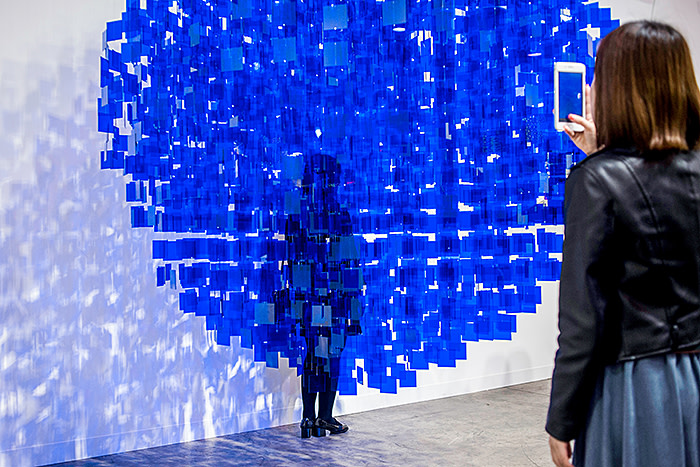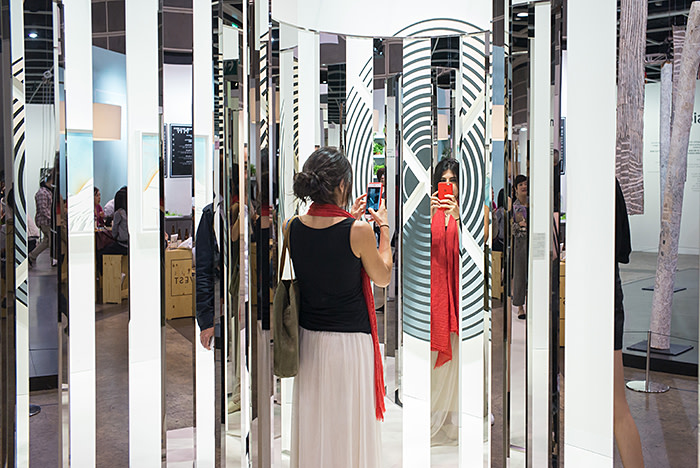The next gen trying to boost Hong Kong’s growing art scene

Roula Khalaf, Editor of the FT, selects her favourite stories in this weekly newsletter.
The scene is jarring. A homeless man is slumped with his head upon the table, a half-eaten tray of McDonald’s food in front of him.
But the man, seemingly taking refuge in a fast-food chain, is in fact a plastic dummy, created by local artist Silas Fong as part of a temporary exhibition hosted by Duddell’s, an upmarket restaurant in Hong Kong.
The Michelin-starred establishment has showcased numerous displays featuring local and international artists since it was co-founded in 2013 by Alan Lo, 38. He is a restaurateur and the son of battery-production tycoon Victor Lo, who is chairman and chief executive of Gold Peak Industries, a HK$600m market-cap company.
The younger Lo, who is an avid art collector, is among a small group of entrepreneurial descendants of Hong Kong’s business elite who are keen to spawn homegrown artistic talent and build what Hong Kong’s art patrons describe as a fledgling but expanding art scene.
Having historically lagged behind other artistic hubs such as New York, London or Venice, Hong Kong has developed rapidly over the past 10 years.

“Hong Kong really began attracting global attention when Art HK, which was later branded Art Basel Hong Kong, opened in 2008,” says Lo. “It was the first attempt to create an international art fair. It’s interesting when you now see a blockbuster show in Hong Kong and people fly in from Jakarta, Singapore, Manila, Shanghai and Tokyo. It’s becoming this regional eco-system.”
In the five years since its opening, Duddell’s has played host to globally renowned artists such as Ai Weiwei, as well as lesser-known, upcoming talent. Lo says he has the flexibility to showcase art as part of the restaurant to enhance the experience. “Duddell’s is unique: we’re not a commercial gallery, we’re not a museum, we’re that in-between platform. In a way, it allows us to do pretty much anything we want: it’s a non-selling space, so we don’t have to worry about the commercial aspect of what’s going to do well. It allows us to really commit to trying new ideas, thinking outside of the box.”
Interest in collecting art has grown in tandem with the rising level of wealth in pockets of Asia and the emergence of a more affluent middle class. The number of ultra wealthy individuals in Asia, classed as those with a net worth of $30m or more, rose 18.5 per cent year on year in 2017 to almost 70,000 people, according to a September report by Wealth-X.

“Hong Kong’s now surpassed New York and London for the highest concentration of high net worth and ultra-high net worth individuals,” says Magnus Renfrew, former founding director of Art Basel Hong Kong. “That means that there’s a great, local collector base.”
Other tycoons are opening venues with spaces dedicated entirely to art.
Kristine Li, the eldest grandchild of Hong Kong property tycoon Lee Shau-kee — the founder, chairman and managing director of Henderson Land Development, one of Hong Kong’s biggest property developers — earlier this year unveiled an art hub called H Queen’s, situated in a prime location on one of Hong Kong’s busiest central streets. Forbes estimates that her family has a net worth of $24.7bn.
“We saw the opportunity to create something more than a typical office, something that would enrich the traditional business landscape,” Li explains. “We have witnessed an increasing demand for the art space in the market and so this was why we thought constructing a purpose-built gallery building would make sense.”
The sleek white and grey building, part of the family business, sits in the centre of Hong Kong’s financial district and is now home to a set of internationally renowned art galleries, restaurants and retail brands. With space so limited and expensive on the island of Hong Kong, H Queen’s is a rarity. There are some art galleries on the island in old, pre-existing buildings but no other art-focused buildings that are purpose-built.

Prominent galleries, such as David Zwirner from New York, Hauser & Wirth from Switzerland and Seoul Auction from South Korea, are now housed at H Queen’s and are helping draw attention to the city, art patrons say.
“The contemporary art scene continues to aspire to be a global cultural hub like New York or London,” says Evan Chow, 36, a renowned financier in the city and avid art collector, as well as a descendant of the Li family founders of the Bank of East Asia. However, Chow argues that Hong Kong still suffers from a dearth of local artistic talent.
“Art fairs such as Art Basel, Art Central and HK Art Week will also drive the evolving scene. However, there seems to be a missing voice of local artists and that’s a huge gap between the art market and practices in the community,” he says.
The next stage of development in the Hong Kong scene, experts say, is the need for more art-dedicated spaces and non-profit organisations so that local artists can blossom. Art in general also needs to be made more accessible to the masses.
Smaller galleries, regarded as fertile ground for local artists, are beginning to gain more traction. New art districts are emerging in more affordable areas of Hong Kong, such as Wong Chuk Hang, an edgy, industrial area on the south of the island.
The recently opened Tai Kwun, a former central police station that has been transformed into the Centre for Heritage and Arts, has a diverse programme dedicated to local artists, Chow says. Alongside Tai Kwun’s exhibitions, the long-awaited M+ museum of visual culture is set to open in Kowloon in 2020 as another non-commercial institution.

As a keen collector of art in his Sai Kung-based personal gallery, Chow has a vested interest and a role to play in the development of promising Hong Kong artists.
“Asian collectors in the field of contemporary art and art patronage are right now extending a higher level of influence,” he says. “It is very important to bring international awareness and resources to the local art scene.”
Yet one of the key factors holding local artists back is the cost of rents in the notoriously space-squeezed city. Although there is a clutch of art-dedicated areas in Hong Kong, space is limited and expensive on the island, stifling the potential profusion of artistic hubs.
“The cost of real estate in Hong Kong is very high and so this puts financial pressure on artists both in living costs but also for studio costs,” says Renfrew. “The high overheads also affect the galleries that could support young artists . . . The price point for the majority of young artists is too low to stack up economically for commercial galleries, with high rents to pay, to represent their work.”
Space in Hong Kong is an emotional and politically heated topic, with the city dubbed the least affordable in the world for eight years in a row, according to a survey by Demographia.
Fong, 33, the artist behind the Duddell’s exhibition, says smaller galleries “might be working for one or two years but then they disappear because they can’t afford the rent”.
“Control of rent is an important issue in general,” he says. “It’s why I spend more time in Korea, it’s more affordable. A lot of my good friends are artists but can’t spend a lot of time on their art, they have to earn money by doing part-time jobs, so 80 per cent of their time is not on their art work.”
Commenting on his “McRefugee” piece at Duddell’s, he adds: “I wanted to be provocative and talk about the reality to those who have the time and money to be in this restaurant. In Mong Kok [district], some people spend 24 hours in McDonald’s. It is a difficult situation where Hong Kong looks very advanced and like a well-developed city, but on the other hand there are a lot of problems.”
Another local artist, Steve Hui, agrees that high rents pose a challenge to artists in the city. Hui previously shared a studio in an industrial area in Kowloon but the burgeoning arts scene was squeezed out by rising rents. “A very good community happened in Kwun Tong organically,” he says. “There were a lot of ideas exchanged and outdoor live performances and gatherings. However, the rent kept rising from around five years ago and most artists moved out from Kwun Tong.”
Hui co-founded Twenty Alpha, a multifunction space for experimental art. It is working to build a new audience from a studio space operated by Art and Cultural Outreach, an organisation that leases space in a building on Hong Kong island to artists for a fraction of market rents.
Finding affordable space in Hong Kong for local artists in particular will remain a challenge, observers say. But tycoons’ descendants believe they have a role to play in using their wealth and influence to build up Hong Kong’s art scene while making it accessible to the public.
The homeless mannequin slumped on the table in the private library at Duddell’s, frequented by Hong Kong’s more affluent diners, is a fitting emblem of the tension surrounding space. He has already moved on, with the latest exhibition muscling in on his spot.
Comments